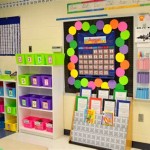Easy Classroom Decoration Ideas For Grade 8 Mathematics
Creating an engaging and stimulating learning environment is crucial for effective mathematics education, particularly in Grade 8, a pivotal year where students solidify foundational concepts and prepare for more advanced mathematical studies. Classroom decoration plays a significant role in fostering a positive attitude towards mathematics and reinforcing key concepts. Simple, cost-effective decorations can transform a mundane classroom into an inspiring space that encourages participation and improves understanding. The following article explores practical and easily implementable decoration ideas tailored for a Grade 8 mathematics classroom.
Utilizing Visual Aids for Reinforcing Mathematical Concepts
Visual aids are indispensable tools for illustrating abstract mathematical ideas and making them more accessible to students. Grade 8 mathematics covers a wide range of topics, including algebra, geometry, statistics, and number systems. Decorations that visually represent these concepts can serve as constant reminders and aid in comprehension.
One effective approach is to create posters that depict fundamental geometric shapes and their properties. For example, a poster illustrating different types of triangles (equilateral, isosceles, scalene, right-angled) with their respective angle and side characteristics can be a valuable reference. Similarly, posters showcasing quadrilaterals (squares, rectangles, parallelograms, trapezoids) with their properties can aid students in visualizing and remembering these shapes. These posters should include clear diagrams, concise definitions, and relevant formulas.
Another useful visual aid is a number line that spans the entire classroom wall. This number line can represent integers, fractions, decimals, and even irrational numbers like π (pi). The number line can be used to demonstrate addition, subtraction, multiplication, and division of integers, as well as the concept of absolute value. Marking key points on the number line, such as perfect squares, perfect cubes, and common fractions, can further enhance its utility.
Algebraic concepts can also be visualized through the use of graphs and charts. Posters displaying different types of graphs, such as linear, quadratic, and exponential functions, can help students understand the relationship between variables and their graphical representation. Creating a coordinate plane on a whiteboard or wall with removable stickers can allow students to actively participate in plotting points and graphing functions. This hands-on approach can significantly improve their understanding of coordinate geometry.
Statistical concepts can be reinforced through the use of histograms, bar graphs, and pie charts. Displaying these charts with real-world data can make statistics more relatable and engaging for students. For example, a bar graph showing the average height of students in the class or a pie chart depicting the distribution of favorite subjects can illustrate the practical applications of statistical analysis.
The Pythagorean theorem is a cornerstone of Grade 8 mathematics and can be effectively illustrated through a visual representation. A poster depicting a right-angled triangle with squares drawn on each side can help students understand the relationship between the sides. Demonstrating the theorem with numerical examples and color-coding the sides can further enhance comprehension.
Creating mnemonic devices or acronyms for remembering formulas and concepts can also be a beneficial decoration strategy. For example, using "PEMDAS" (Parentheses, Exponents, Multiplication and Division, Addition and Subtraction) to remember the order of operations or "SOH CAH TOA" (Sine = Opposite/Hypotenuse, Cosine = Adjacent/Hypotenuse, Tangent = Opposite/Adjacent) for trigonometric ratios can be visually displayed on posters to aid in memorization.
Incorporating Interactive Elements and Student Contributions
Engaging students in the decoration process not only makes the classroom more vibrant but also fosters a sense of ownership and responsibility. Incorporating interactive elements allows students to actively participate in learning and reinforces their understanding of mathematical concepts.
One interactive idea is to create a "Problem of the Week" board. This board can feature a challenging mathematical problem that students can attempt to solve throughout the week. The solution can be posted at the end of the week, along with the names of the students who successfully solved the problem. This encourages problem-solving skills and promotes a collaborative learning environment.
Designing a "Math Jokes" corner can add a touch of humor to the classroom and make mathematics more approachable. Students can contribute math-related jokes, riddles, or puns, which can be displayed on a bulletin board. This promotes creativity and encourages students to think about mathematics in a lighthearted way.
Creating a "Math Concepts in the Real World" display can help students connect mathematics to their everyday lives. Students can bring in examples of how mathematical concepts are used in various fields, such as architecture, engineering, sports, and finance. These examples can be displayed on a bulletin board, along with explanations of the underlying mathematical principles. This helps students appreciate the relevance of mathematics and motivates them to learn.
Another interactive element is to create a "Math Word Wall." This wall can feature important mathematical terms and definitions. Students can contribute to the word wall by adding new terms and definitions as they learn them. This helps them build their mathematical vocabulary and reinforces their understanding of key concepts. The words can be organized alphabetically or by mathematical topic.
Incorporating manipulatives, such as geometric solids, fraction bars, and algebra tiles, into the decorations can also be beneficial. These manipulatives can be displayed on shelves or in containers, allowing students to access them easily. Using these manipulatives during lessons can enhance understanding and make abstract concepts more concrete.
Creating a "Math Timeline" that highlights important historical events and mathematicians can provide students with a broader perspective on the development of mathematics. The timeline can include dates, names, and brief descriptions of key discoveries and achievements. This can inspire students to learn more about the history of mathematics and appreciate its significance.
Utilizing student artwork related to mathematical concepts can also personalize the classroom and showcase student talent. Students can create drawings, paintings, or sculptures that represent mathematical ideas. These artworks can be displayed on walls or shelves, adding a creative touch to the classroom environment.
Employing Cost-Effective and Sustainable Decoration Strategies
Classroom decorations do not need to be expensive or elaborate to be effective. Utilizing cost-effective and sustainable strategies can create a visually appealing and engaging learning environment without breaking the budget. Repurposing materials and involving students in the creation process can also promote environmental awareness and resourcefulness.
Using recycled materials to create decorations is a great way to save money and promote sustainability. For example, cardboard boxes can be transformed into geometric solids, plastic bottles can be used to create decorative containers, and old newspapers can be used to make paper mache sculptures. These projects can be a fun and engaging activity for students, teaching them about recycling and reusing materials.
Utilizing printable resources from online educational websites is another cost-effective way to decorate the classroom. Many websites offer free posters, charts, and worksheets that can be printed and displayed. These resources can cover a wide range of mathematical topics and can be easily customized to suit the needs of the classroom.
Creating decorations using simple craft supplies, such as construction paper, markers, and glue, is also a budget-friendly option. Students can create colorful posters, banners, and mobiles that represent mathematical concepts. These decorations can be easily customized to reflect the current curriculum and can be updated as needed.
Utilizing chalkboard paint to create a large writable surface on a wall or table can provide a versatile and cost-effective decoration option. This surface can be used for writing equations, drawing diagrams, or creating interactive games. Chalkboard paint is relatively inexpensive and can be easily applied to any smooth surface.
Growing plants in the classroom can add a touch of nature and create a more calming and inviting environment. Plants can also be used to illustrate mathematical concepts, such as Fibonacci sequence and symmetry. Selecting low-maintenance plants that are easy to care for is important to ensure their survival.
Using string lights to add a warm and inviting glow to the classroom can be a simple and inexpensive way to enhance the atmosphere. String lights can be hung around the perimeter of the room or used to highlight specific decorations. Using LED string lights can save energy and reduce costs.
Creating a positive and welcoming classroom atmosphere is essential for promoting student engagement and learning. Decorations that are visually appealing, interactive, and relevant to the curriculum can significantly enhance the learning experience. By utilizing cost-effective and sustainable strategies, teachers can create an inspiring and stimulating mathematics classroom that fosters a love of learning.
Math Classroom Decoration And Bulletin Board Inspiration Rise Over Run
Math Bulletin Board And Door Ideas Rise Over Run

Buy Math Symbols Bulletin Board Classroom Decorations For Elementary Middle Or High School To Print And Hang Reference Wall In

10 Ideas For Decorating Your Math Classroom Rise Over Run
Math Classroom Decoration And Bulletin Board Inspiration Rise Over Run

10 Creative Math Classroom Decoration Ideas For Teachers

Math Bulletin Board And Door Ideas Rise Over Run

10 Creative Math Classroom Decoration Ideas For Teachers

50 Inventive Math Bulletin Board Ideas Teachervision

18 Creative Math Bulletin Board Ideas To Engage Students







